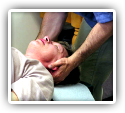
Chiropractic Adjustments Safe According to Scientific Review
2013-10-14
 A literature review published in the September 2013 issue of the International Journal of Clinical Practice and online at www.medscape.com by P. Tuchin examined 18 studies discussing what the researchers termed "spinal manipulative therapy" (SMT) and stroke to determine if SMT was a causative or associative factor.
A literature review published in the September 2013 issue of the International Journal of Clinical Practice and online at www.medscape.com by P. Tuchin examined 18 studies discussing what the researchers termed "spinal manipulative therapy" (SMT) and stroke to determine if SMT was a causative or associative factor.
There has been rumors of stroke following SMT. Reports not based upon any statistical evidence vary from 1 case in every 400,000 to 1 in 5.6 million. The prejudicial tendencies by some in the medical community toward chiropractic have created controversial views of chiropractic SMT having a higher risk of stroke than other types of SMT. This literature review attempted to cut through the hype and, "…assess any misconceptions or distortion of the results of studies on chiropractic and stroke."
This review noted that sixty percent of strokes occur due to an abnormal amount of lipids (cholesterol and/or fat) in the blood. Smoking, hypertension, obesity, cardiovascular disease, types 1 & 2 diabetes, atrial fibrillation, migraines, heavy drinking, infections, contraceptives, sleep apnea, illicit drug use, and other factors also put a person at higher risk for stroke.
Chiropractic adjustments or SMTs are not listed in the scientific literature as a major factor in stroke. The researcher Tuchin explained, "The evidence for causality of vertebral artery dissection from chiropractic is weak."
Tuchin examined the studies that suggested that chiropractic SMT caused stroke in patient cases, looking for other factors and explanations that may have been the real causative factor. To test for a causal relationship, nine specific criteria were used. The scientific criteria included: strength of evidence, consistency, specificity, temporality, biological gradient or dose-response relationship, plausibility, other explanations, experimental confirmation, and coherence.
Strength criteria findings showed that the number of cases examined in each study were too small not to question the results. Dose-response relationship criteria showed flaws in the 18 studies of chiropractic SMT and stroke because the studies actually examined cases where SMT was not done by chiropractors but rather by other professions like massage therapists and MDs. Every criteria examined by Tuchin revealed serious flaws and inconsistencies in the studies and their results.
After examining the 18 studies for the criteria, Tuchin states, "There is lack of compelling evidence that SMT is causally associated with stroke. Physical triggers, including SMT, can serve as plausible final link between the underlying disease and stroke."
Tuchin concludes by stating, "The quality of evidence suggesting causation between chiropractic and VAD is mostly weak. Therefore, causality between chiropractic and vascular accidents has not been determined."

.png)
